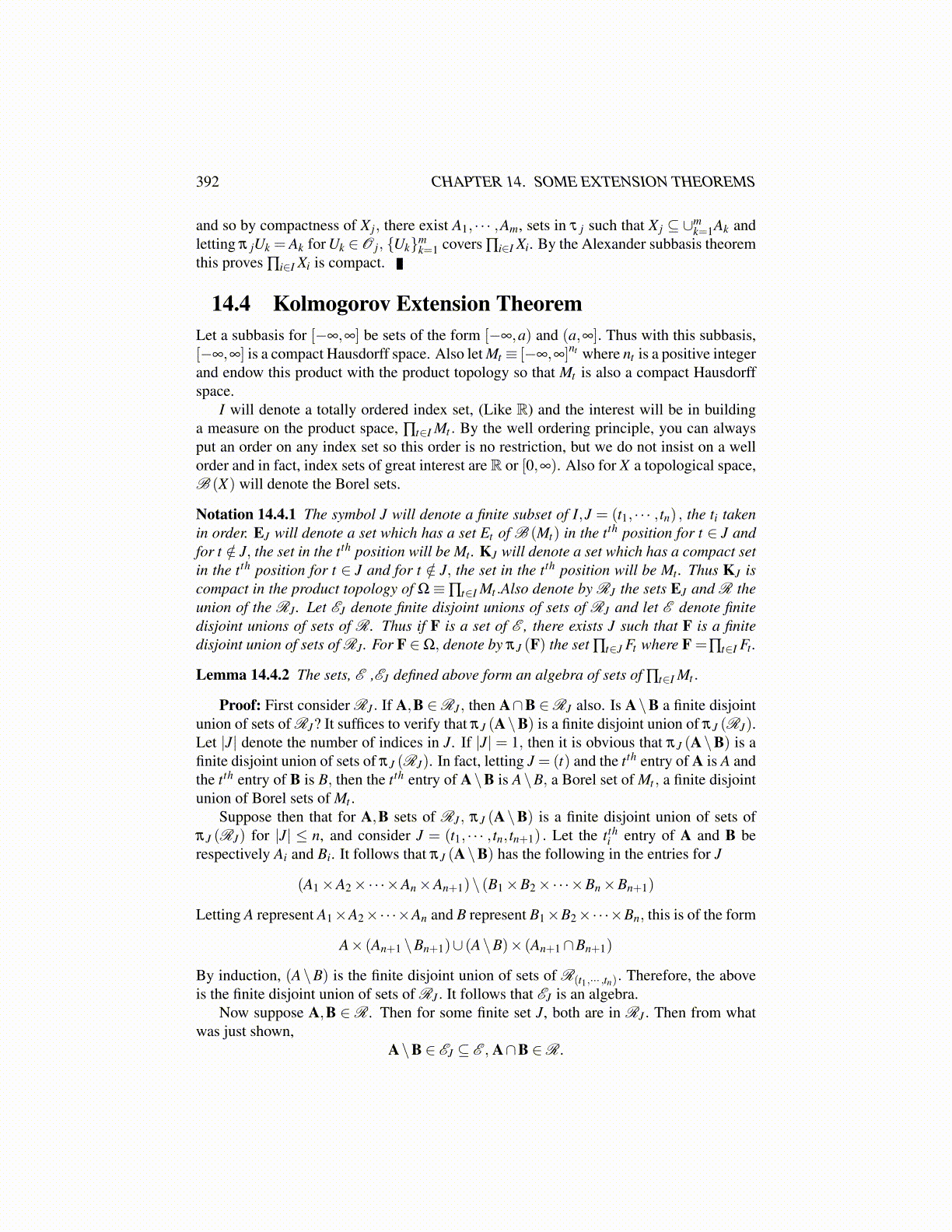
392 CHAPTER 14. SOME EXTENSION THEOREMS
and so by compactness of X j, there exist A1, · · · ,Am, sets in τ j such that X j ⊆ ∪mk=1Ak and
letting π jUk = Ak for Uk ∈O j, {Uk}mk=1 covers ∏i∈I Xi. By the Alexander subbasis theorem
this proves ∏i∈I Xi is compact.
14.4 Kolmogorov Extension TheoremLet a subbasis for [−∞,∞] be sets of the form [−∞,a) and (a,∞]. Thus with this subbasis,[−∞,∞] is a compact Hausdorff space. Also let Mt ≡ [−∞,∞]nt where nt is a positive integerand endow this product with the product topology so that Mt is also a compact Hausdorffspace.
I will denote a totally ordered index set, (Like R) and the interest will be in buildinga measure on the product space, ∏t∈I Mt . By the well ordering principle, you can alwaysput an order on any index set so this order is no restriction, but we do not insist on a wellorder and in fact, index sets of great interest are R or [0,∞). Also for X a topological space,B (X) will denote the Borel sets.
Notation 14.4.1 The symbol J will denote a finite subset of I,J = (t1, · · · , tn) , the ti takenin order. EJ will denote a set which has a set Et of B (Mt) in the tth position for t ∈ J andfor t /∈ J, the set in the tth position will be Mt . KJ will denote a set which has a compact setin the tth position for t ∈ J and for t /∈ J, the set in the tth position will be Mt . Thus KJ iscompact in the product topology of Ω≡∏t∈I Mt .Also denote by RJ the sets EJ and R theunion of the RJ . Let EJ denote finite disjoint unions of sets of RJ and let E denote finitedisjoint unions of sets of R. Thus if F is a set of E , there exists J such that F is a finitedisjoint union of sets of RJ . For F ∈Ω, denote by πJ (F) the set ∏t∈J Ft where F =∏t∈I Ft .
Lemma 14.4.2 The sets, E ,EJ defined above form an algebra of sets of ∏t∈I Mt .
Proof: First consider RJ . If A,B ∈RJ , then A∩B ∈RJ also. Is A\B a finite disjointunion of sets of RJ? It suffices to verify that πJ (A\B) is a finite disjoint union of πJ (RJ).Let |J| denote the number of indices in J. If |J| = 1, then it is obvious that πJ (A\B) is afinite disjoint union of sets of πJ (RJ). In fact, letting J = (t) and the tth entry of A is A andthe tth entry of B is B, then the tth entry of A\B is A\B, a Borel set of Mt , a finite disjointunion of Borel sets of Mt .
Suppose then that for A,B sets of RJ , πJ (A\B) is a finite disjoint union of sets ofπJ (RJ) for |J| ≤ n, and consider J = (t1, · · · , tn, tn+1) . Let the tth
i entry of A and B berespectively Ai and Bi. It follows that πJ (A\B) has the following in the entries for J
(A1×A2×·· ·×An×An+1)\ (B1×B2×·· ·×Bn×Bn+1)
Letting A represent A1×A2×·· ·×An and B represent B1×B2×·· ·×Bn, this is of the form
A× (An+1 \Bn+1)∪ (A\B)× (An+1∩Bn+1)
By induction, (A\B) is the finite disjoint union of sets of R(t1,··· ,tn). Therefore, the aboveis the finite disjoint union of sets of RJ . It follows that EJ is an algebra.
Now suppose A,B ∈ R. Then for some finite set J, both are in RJ . Then from whatwas just shown,
A\B ∈ EJ ⊆ E , A∩B ∈R.